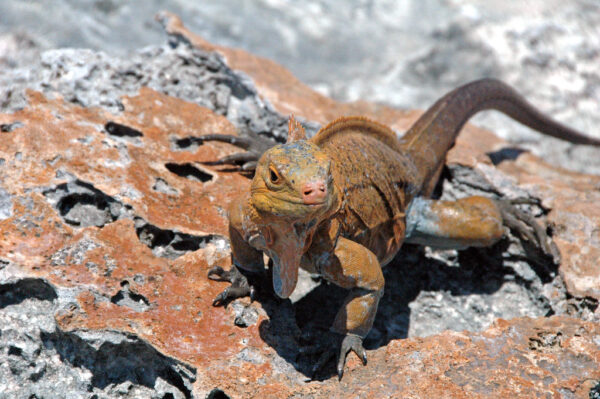The San Salvador iguana (Cyclura rileyi) is a critically endangered lizard species native to the Caribbean island of San Salvador in the Bahamas. It is one of three species of Bahamian iguanas, all endangered. This species’s unique physical appearance and behavior make it an interesting creature to learn about.
Scientific Name
The scientific name for the San Salvador iguana is Cyclura rileyi. It belongs to the family Iguanidae, which includes other lizards such as green iguanas and chuckwallas.
Physical Traits
San Salvador iguanas have a distinct physical appearance that distinguishes them from other lizards. They have grayish-brown skin with yellow markings on their backs and sides, giving them a mottled look. They also have spiny scales on their tails and heads, which can be used for defense against predators. Males are typically larger than females, reaching up to two feet in length and weighing up to five pounds.
Lifespan
San Salvador iguanas can live up to 15 years in the wild, although captive specimens may live longer due to better care and nutrition.
Habitat
San Salvador iguanas are found only on the island of San Salvador in the Bahamas. They inhabit rocky areas near beaches or coastal cliffs where they can shelter from predators and access food sources such as cactus plants and flowers.
Diet
San Salvador iguanas are entirely vegetarian and sustain themselves mainly on cactus plants, flowers, fruits, leaves, and other vegetation in their habitat. They also eat insects occasionally but do not rely on them as a major food source.
Reproduction
San Salvador iguanas reach sexual maturity at around two years old and breed between May and July each year during the rainy season. Females lay clutches of up to 16 eggs per season, hatching after about 90 days of incubation. The young lizards leave their nests after hatching and fend for themselves in the wild without parental care or protection from predators.
Conservation Status
The International Union for Conservation of Nature (IUCN) lists the San Salvador iguana as critically endangered. Its population has declined due to habitat destruction caused by human activities such as development projects on its native island and predation by introduced species like cats and rats that prey upon its eggs or young lizards before reaching adulthood. Conservation efforts such as captive breeding programs have been implemented in recent years with some success, but more needs to be done if this species will survive into future generations.
Interesting Facts
The San Salvador iguana is one of only three species of Bahamian rock iguanas left in existence today; all others have gone extinct due to human activities over time. It is also known for its unique ability to change color depending on its environment; when exposed to sunlight, it will become darker. When kept out of direct sunlight, it will become lighter colored again over time!

